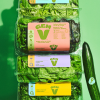
In this article, we share the recommendations from the guide to packaging eco-design created by LG2 and Eco Entreprises Québec.
Consumers are increasingly aware of the environmental impacts of current production and consumption methods, and they are right to push companies to do better. This guide explores the importance of rethinking packaging in the context of an eco-conscious approach to meet environmental, social, and economic criteria at every stage of its life cycle.
Packaging plays a crucial role in protecting, transporting, preserving, selling, and communicating information about products. However, the goal is not to avoid packaging at all costs but rather to reflect on its roles and its overall environmental impact. It also emphasizes that food waste often has a more significant environmental impact than the packaging itself.
The guide warns against blindly following trends or fads, highlighting the need for creative agencies and designers to step back before jumping on a trend that may not be environmentally sound in the long run.
Regarding plastics, the issue often lies in their single-use and short lifespan. The guide encourages thinking about solutions rather than completely avoiding plastic, pointing out that some plastics can be recycled and reused.
While recycling is crucial in packaging management, the guide cautions against excessive focus on this step, emphasizing the importance of considering the complete life cycle of the packaging. Additionally, it explains that composting is not intended to manage plastic packaging but to produce quality compost from organic and putrescible materials.
The guide also addresses the confusion surrounding the terms "biodegradable" and "compostable," warning against misleading claims on some packaging. It underscores the importance of designing packaging while considering standards, regulations, and specificities, urging patience and humility in the eco-design process.
Finally, the guide provides a practical list of recommendations for designing more sustainable packaging, from reducing mass to using recyclable and transparent materials, while avoiding certain toxic substances. It also encourages supporting local suppliers and designing packaging consisting of a single material to facilitate recycling.
To download the complete guide go to :
https://lg2.com/en/news/how-to...


